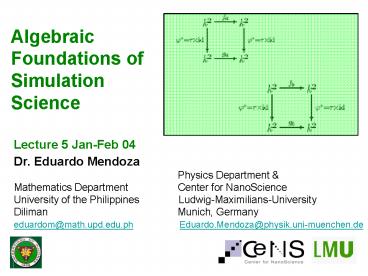Algebraic Foundations of Simulation Science - PowerPoint PPT Presentation
1 / 40
Title:
Algebraic Foundations of Simulation Science
Description:
Basic Extensions (1): Ugraphs. Basic Extensions (2): Pographs. SDS on pographs ... Lecture Series on 'Algebra of Simulations' in August/September 2004 ... – PowerPoint PPT presentation
Number of Views:33
Avg rating:3.0/5.0
Title: Algebraic Foundations of Simulation Science
1
Algebraic Foundations of Simulation Science
- Lecture 5 Jan-Feb 04
- Dr. Eduardo Mendoza
- Physics Department
- Mathematics Department Center for
NanoScience - University of the Philippines
Ludwig-Maximilians-University - Diliman Munich, Germany
- eduardom_at_math.upd.edu.ph
Eduardo.Mendoza_at_physik.uni-muenchen.de
2
Topics to be covered
- Motivation for the theory
- Sequential Dynamical Systems (SDS)
- Morphisms of SDS
- State Spaces of SDS
- Products and the Decomposition Theorem
- Further graduate research areas
3
1. Motivation for the theory
- References
- Finite Dynamical Systems 28.02.2001 (by
Reinhard Laubenbacher and Bodo Pareigis) - Decomposition and Simulation of Sequential
Dynamical Systems 20.06.2002 (by Reinhard
Laubenbacher and Bodo Pareigis) . - Update Schedules of Sequential Dynamical Systems
20.06.2002 (by Reinhard Laubenbacher and Bodo
Pareigis)
4
Need for a Science of Simulations
- On one hand
- Computer simulations becoming ubiquitous tool for
complex systems study - Variety (Zoo ?) of toolscontinuous, discrete,
hybrid--available
- On the other
- Few scattered results on structure and dynamics
of simulations - Simulation is still largely an art form
- Comparison of different simulations (of a system)
comparison of different implementations
difficult
5
Some questions...
- How to replace a large simulation with a
equivalent smaller one? - How in general to relate structures and dynamics
(their state spaces) of simulations? - Can a large simulation be decomposed into
smaller ones? If yes, is this (in some
appropriate sense) unique?
6
The original SDS concept(Barrett-Reidys, 1999)
For k 0,1
is
7
Generalization (Laubenbacher-Pareigis, 2001)
- in the following aspects
- allow state set k to be arbitrary
- no restrictions on the local functions fa with
respect to symmetry - more general update schedules
- use of only a subset of local functions for
global function construction - arbitrary repetitions allowed
8
2. Sequential Dynamical Systems
- Review of graph theory concepts
- (loop-free, undirected) graph
- graph morphism
- subgraph
- connected components of a graph
- 1-neighborhood (or vicinity) of a graph vertex
9
Notation
10
Permutation SDS ( original SDS)
11
Sequential Dynamic System (SDS)
12
3. Morphisms of SDS
- To define a morphism of SDS, we have to consider
the following data which may be changed by maps - the graph F
- the local functions fa
- the word a
- the set of states ka
13
Adjoint map on state spaces
14
Morphism definition considerations
15
Examples for motivation (1)
16
Example on motivation (2)
17
Example Motivation (3)
18
Example Motivation (4)
19
Morphism definition (1)
20
Morphism definition (2)
21
Further example
22
Composition of morphisms
23
4. State spaces of SDS
- Definitions
- 1.The directed graph (kn, Ef) for a function f
kn ? kn and Ef (x,f(x))x ? kn is called
the state space of f. - 2.A commutative diagram is
called a morphism of the functions f, g and
defines a morphism of directed graphs
24
Main Result
25
5. Products and the Decomposition Theorem
26
Projection morphisms
27
SDS Indecomposability
28
Morphism decompositions
29
Simulation comparisons (1)
30
Simulation comparisons (2)
31
Theory Evaluation
32
Theory Limitations
33
Solution Approach
34
Basic Extensions (1) Ugraphs
35
Basic Extensions (2) Pographs
36
SDS on pographs
37
6. Coop with Bodo Pareigis (LMU)
- Minisymposium
- SIAM Conference on Discrete Mathematics (Session
MS22) - Sequential Dynamical Systems a Mathematical
Foundation of Computer Simulation - 11.-14. August 2002, San Diego, CA, USA
- Sequential dynamical systems (SDS) were
constructed as abstractions of computer
simulations. They are similar to cellular
automata, but carry more structure, which allows
a successful mathematical analysis. - SDS theory was first developed at Los Alamos
National Laboratory (LANL) under Chris Barrett in
context with large-scale traffic simulations. - SDS theory also proves to be a rich mathematical
subject. In a categorical framework one studies
approximations of dynamical systems by SDS. This
allows the mathematical formulation of questions
regarding the replacement of one simulation by
another, their linearizations, and the
relationship between structural features of a
simulation and the resulting dynamics
- Finite Dynamical Systems 28.02.2001 (by
Reinhard Laubenbacher and Bodo Pareigis) - Decomposition and Simulation of Sequential
Dynamical Systems 20.06.2002 (by Reinhard
Laubenbacher and Bodo Pareigis) . - Update Schedules of Sequential Dynamical Systems
20.06.2002 (by Reinhard Laubenbacher and Bodo
Pareigis)
38
Coop with Prof. Laubenbacher (VBI/Virginia Tech)
39
Planned Activities to Support
- Joint Seminar _at_ LMU with B. Pareigis Sequential
Dynamic Systems (April-July 04) - Lecture Series on Algebra of Simulations in
August/September 2004 - Co-advise PhD/MS theses with B. Pareigis and
R.Laubenbacher (starting Fall 04)
40
Thanks for your attention !
- Questions?































